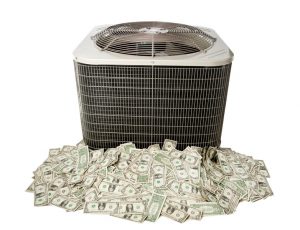
Are you currently debating about a new air conditioning installation in Portland, OR? You have come to the right people! We never take any shortcuts when we install a new system. Many contractors will only rip out the old system and stick a new one in. We take the time to ensure our customers have the right new air conditioner to meet the cooling needs of their house and see that it is installed so it will run at maximum efficiency. We have the confidence to back any system we install with a 100% Satisfaction Guarantee.
We’d like to share some of our expertise about one of the most important factors when considering a new air conditioner: it’s efficiency rating. These ratings can be confusing to people, and there are some assumptions homeowners may have about what they mean.
SEER and EER
The two main efficiency ratings for central air conditioning systems are the seasonal energy efficiency ratio (SEER) and energy efficiency ratio (EER), respectively. As you may guess from the names, they are similar, but with a singular important difference.
SEER is the main rating to pay attention to. It is a ratio of the amount of cooling power a unit can create (by removing heating from the air) to the amount of electricity it consumes. The measurements used to determine SEER are done over a variety of conditions (temperature, humidity) to simulate an entire season of cooling a house. The final ratio is BTUs of cooling to electricity in watt-hours. The higher the number, the better the AC is at converting electricity to cooling over a summer.
EER is the same ratio, but with this difference: the measurements are made under a single set of conditions. Think of EER as a “snapshot” of cooling power, while SEER is a long “video.” For any given air conditioning system, SEER is always higher than EER.
What to Look for in SEER/EER
You know what the ratings are, but what are “good” numbers for SEER/EER? Higher doesn’t necessarily mean a certain air conditioning system is the one to buy, since the higher the rating, the more expensive the system because of the special features necessary for high-efficiency. (They include multi-stage compressors and variable-speed fans.) However, we strongly recommend purchasing a system that meets the ENERGY STAR requirements, a government program to help guide consumers toward energy-saving systems. The minimum for a central AC to receive ENERGY STAR certification is 15 SEER/12.5 EER.
A Caution About Ratings
It’s important for you to know that high SEER/EER is not an automatic guarantee of lower utility bills. Choosing a unit only because of high-efficiency ratings can lead to getting the entirely wrong type of AC for your needs. This is why it’s vital to work with seasoned and trustworthy professionals. If the installation is done incorrectly or the air conditioner is sized so its too large or too small, it won’t matter what the SEER/EER ratings are—the unit will underperform and cost too much to run. Make an appointment with our experts and we’ll see you have the ideal new cooling for your house.
Clawson Heating & Air Conditioning: “Connecting people to Comfort!” in the Greater Portland Area. How can we make your day better?
